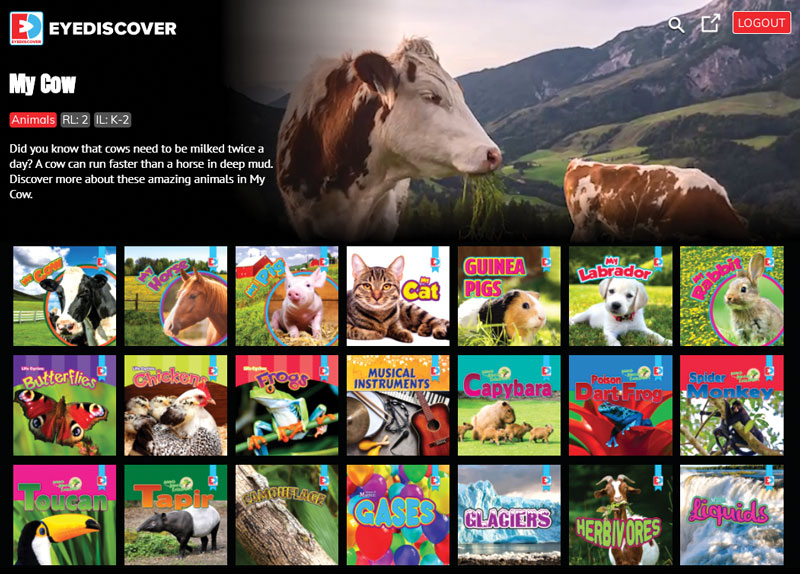Weigl’s EyeDiscover | Reference Database Review
EyeDiscover is a set of “media-enhanced” nonfiction ebooks, serving as a stand-alone platform for young readers, kindergarten through second grade, or as an extension or complement to corresponding print books from the same publisher, AV2.

URL eyediscover.com/buy-subscription.php
Grade Level K-Gr 2
Cost Access to the entire platform is $399 per year or $999 for a three-year subscription. Individual titles are available along with print book purchase. The library-bound books retail for about $28 each and include a code to open up the “optic readalong” for that book. Contact the publisher for district pricing or multiple-subscription bundles with other products.
Content EyeDiscover is a set of “media-enhanced” nonfiction ebooks, serving as a stand-alone platform for young readers, kindergarten through second grade, or as an extension or complement to corresponding print books from the same publisher, AV2.
The ebooks are indexed on a colorful, engaging landing page. The interface is neat, bright, and crisply designed. Currently there are 160 titles listed, about 30 of which are in Spanish.
Book cover images are arranged as tiles at the bottom of the home page. Most of the top of the page is taken up with information (series category, reading and interest levels, brief description, and a looping, 10-second video) about one of the books—by default the first book in the list. The view can be changed by moving the cursor to another tile.
The information pane cannot be minimized or dismissed and crowds out the title menu. Inside the information pane, the series category indicator appears like a button; users might think that clicking it will yield similar titles, but the button doesn’t respond when touched. There is a search function, activated via a magnifying glass icon, though it does not include any tools or filters. A search for “science” brings up 55 titles, many classified as “science” or “science and nature,” includingGases, Rainbows, Glaciers, and Northern Lights, but also several that are seemingly unrelated, such as Chinese New Year and Basketball.
Other topics include sports and recreation, social studies, the plant kingdom, and senses and sensation.
Once a book is opened, the text is read aloud by a human voice at a comfortably moderate pace, but there are no controls for slowing or increasing the speed of the audio and no option to have text highlighted as it is read. A speaker icon appears at one side of the page to mute the read-aloud, but the choice is not static; the book continues to read aloud every time the page is advanced.
Clicking a book icon that appears on each page brings up a preview bar showing the pages from the print book that correspond to the same text in the digital version. The images of print book pages are not viewable in more than thumbnail size.
Above a text bar on each page, rather than a stationary photo or image, a video illustration plays for anywhere from a few seconds to nearly a minute, though students can move forward or backward from the page at any time. From dolphins swimming together to men playing basketball to a time-lapsed Popsicle melting to demonstrate change in states of matter, the videos are engaging, high-definition, and appropriate for the text.
Students advance the pages at their own pace by clicking on an arrow icon but cannot pause once an individual page’s narration has begun. The videos repeat until the next page is loaded.
The resource is marketed as being “built to work on every device” and optimized for iPad. However, as tested on a sixth-generation iPad, load time for the index page, both on startup and when closing a book, was slow, consistently more than a minute, and the read-aloud was not functional.
Student and teacher resources EyeDiscover lacks tools for integration with learning management systems or other programs; utilities for assigning books to individual students or tracking reading, as in other ebook platforms such as Renaissance’s myON; and quizzes, activities, or lesson plans.
Ebooks have no illustrations, diagrams, or maps, only the text and brief videos. Video cannot be downloaded or saved. Text cannot be copied digitally. The digital versions of the books contain no citation or sourcing information, not even a copyright date or, in nearly every case, an author name. There are no suggestions for further reading or links to additional resources.
Verdict If used simultaneously with the associated print books, EyeDiscover could provide young students with an added dimension of immersion and engagement with reading and with content area material. As a stand-alone resource, it is poor in features and difficult to navigate. Not recommended.
Bob Hassett, Luther Jackson M.S., Falls Church, VA
RELATED
The job outlook in 2030: Librarians will be in demand
The job outlook in 2030: Librarians will be in demand
ALREADY A SUBSCRIBER? LOG IN
We are currently offering this content for free. Sign up now to activate your personal profile, where you can save articles for future viewing






Add Comment :-
Comment Policy:
Comment should not be empty !!!